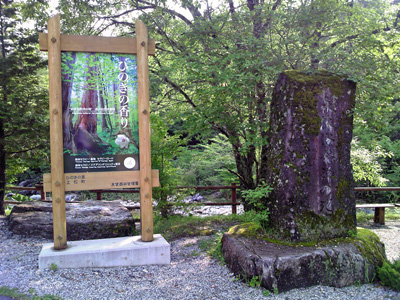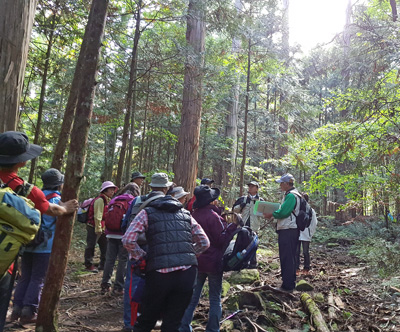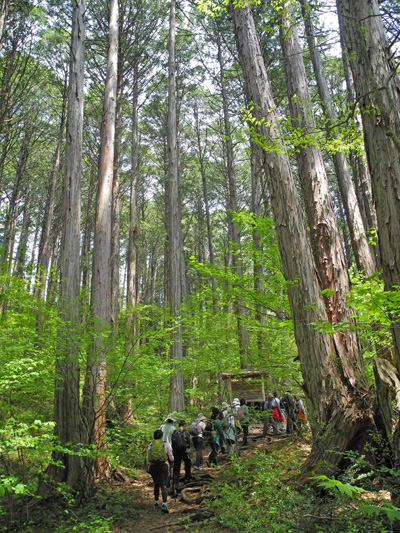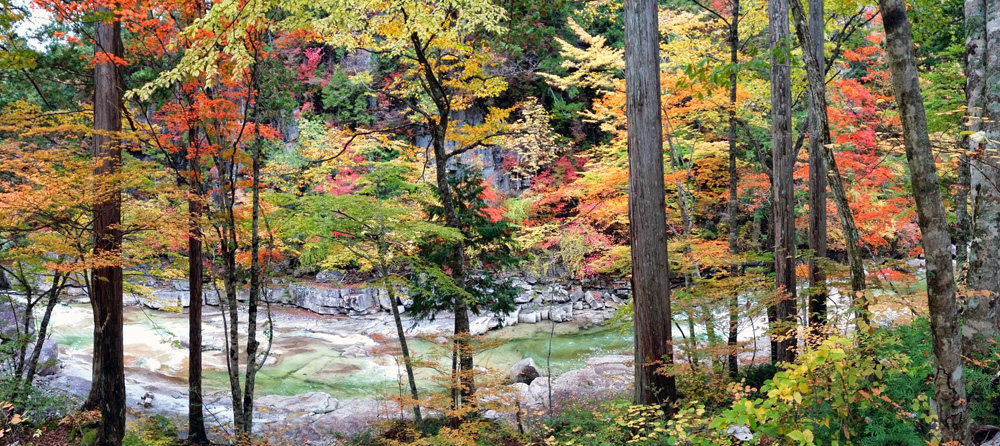
Part 3
 |
Part 3
|

| Akasawa Natural Recreational Forest, one of Japan’s 3 forests of outstanding beauty. The forest is filled with over 300-year-old natural Kiso cypress trees; however, it cannot be considered a virgin forest. In the mid-1600s, the governing Owari clan placed the forest under a strict protection plan, which can be considered the establishment of the current forest. A Guide to Forest Bathing & Forest Therapy |
| What is Forest Bathing? Are you familiar with a refreshing feeling or invigorating sensation when seeing or walking through a beautiful forest? It is a variety of elements such as the natural landscapes and aromas working together to create these sensations. Substances emitted by plants, called “Phytoncide”, along with the fresh green colors and clear air and water are said to be beneficial to people’s health. In fact, the term “Forest Bathing” has its origins in the practice of walking through forests in order to take advantage of these health benefits. The birth of forest bathing is considered to have taken place in Japan, in 1982. At that time, the first Forest Bathing Event was held within the Akasawa Natural Recreational Forest. While “forest bathing” became an everyday term, the actual health benefits remained rather ambiguous and awaited medical clarification. This is the aim of the Forest Therapy Project. In 2006, at 10 forests across the country, the world’s first medical trials of forest therapy were conducted. In these trials, the relaxing effects of the forest were apparent. The strengthening and enhancement of immune function through NK (natural killer) cells was confirmed the following year. In 2015, the concept of forest bathing was seeing increased media coverage in the USA and increasing attention was being paid to the relationship between forests and human health. |
 |
The benefits of forest bathing discovered by the Forest Therapy Project
| Allow us to introduce some of the studies elucidating the health benefits of forest bathing that have been carried out in forests all over Japan, including the findings of research conducted within Akasawa Natural Recreational Forest. The Forest Therapy Base Certification Survey was conducted in 2006. The subjects in this comparative trial were groups of male college students, carrying out the same activities in forest and urban environments. Data recorded included psychological questionnaires, the reaction rates of body chemistry, blood pressure, and measurements of salivary stress markers. The forest results showed a more relaxed state of body and mind compared to those from urban areas. In particular, following a stroll through the forest, stress makers were greatly reduced in comparison to the city cohort. Next, in 2007, “12 tired office workers” were selected from Tokyo, to spend two nights and three days in Akasawa. The experiment recorded blood composition, urine samples, as well as additional studies examining, for example, immune functions that act on cancer cells, contributing to a more clinical perspective. Comparing results from the same subjects, a three-day trip to another city saw no significant change in NK cells. However, when travelling to the forest, the function of NK cells was seen to increase by 56% by the morning of the third day. The effect was seen to persist for up four weeks, gradually declining over this period. It is hoped that this study might also have a bearing on preventative medicine and rehabilitation after cancer treatment. From 2013 to 2015, a University Research Committee was organized, and a 3-year study conducted in Akasawa. The focus is on middle-aged and elderly men and women, and the health benefits and possible effects regarding lifestyle-related diseases. The study’s results have been published in international research journals since 2015. |
 These effects are also explained in the “Walk with a Doctor, Forest Therapy Woodland” event. |
Akasawa Natural Recreational Forest, Forest Bathing Menu
| The Akasawa Natural Recreational Forest is visited by about 100,000 visitors every year. This figure includes not only first-timers but also a large number of repeat visitors. There are also a variety of ways to enjoy the forest. Here, we will introduce the ‘Akasawa strolling menu’, for visitors wanting to experience the forest for the time. |
Estimated Time Required
|
|
1.Forest Walks Akasawa’s forest walks are around 2 -3 km per circuit. It is also possible to arrange a maximum distance of around 10 km by combining courses. In order to prolong the effects of forest bathing, specialty wood-carved goods & cypress essential-oil products are also recommended. |
 |
|
|
2.Guided Walks Akasawa Natural Recreational Forest has an active group of local forest instructors and guides. The Akasawa Therapy Experience Center is maintained by the NPO, “Kiso Hinokinomori” (Cypress Forest). We also provide private guide services to both individuals and organizations. The guided walk plan takes an average of 120 minutes. There are also cases that include lunch before or after the walk and take around 150 minutes. It is also possible to take a 90-minute tour, but as the tour can become a little hectic, we recommend the longer, more leisurely, options. Please send any requests and bookings for a guided tour to the contact details of the Agematsu Town Tourism Association. Please make any guide arrangements at least 1 week before your visit.
|
 |
|
|
3.Only riding the forest railway There are some visitors who tell us, “The time for my visit is extremely limited and I just want to ride the Forest Railway!” If it is outside the peak season, then please refer to the following sample plan:
However, this plan is so squeezed that it may be difficult to fully enjoy Akasawa’s natural forests and beautiful valleys. Perhaps we can only make a small recommendation. At busy times, the Forest Railway uses a ticketed queue management system. As Akasawa is located deep in the mountains, please try to leave time to spare in your schedule. |
 |
Akasawa Forest Bathing Event
Forest bathing events have been held continuously since 1982. The annual events take place twice a year, in spring and fall.
Gather in the Akasawa Natural Recreational Forest to enjoy forest bathing with the guides. There is a choice of two courses, the academic study course, and the friendship course. Take your walking ability into consideration and choose the ideal option for you. Estimated Opening of Reservations Spring event, Beginning of May Fall event, Mid-September |
 |
|
Highlights of the Four Seasons

| Spring The snow melts, and it is time to welcome the season of fresh green. Akasawa Natural Recreational Forest is also bursts into glorious blooms of spring flowers. The park opens for the year on April 29th. Due to the climate, there are large temperature variances from hot to cool, but in the forest at this time, wildflowers are coming into bloom. Next, from Early-May, the pale pinks of Akayashio (Rhododendron pentaphyllum var. nikoense) flowers (right image) spread from the lower reaches of the valley. Then the forest enters Rhododendron dilatatum season. From there a variety of Rhododendrons bloom one after another followed by azaleas. As the buds open on the trees, the mountains are painted in abundant shades of green. You can clearly make out the cypress trees coexisting with hardwood trees, both being fond of sunlight. As mid-summer approaches, the shades of green become more difficult to distinguish, but the mountainsides in this season are transformed into a bustling patchwork. |
 |
| Summer Akasawa’s summer begins at the start of June. The young leaves of hinoki cypress trees fill the forest with a refreshing fragrance, making this the best season for forest bathing. Although people often stay indoors during the rainy season, the morning following rainfall is, in fact, the optimal time for forest bathing. The trees take in plentiful reserves of water, producing abundant phytoncide. Additionally, as the fragrant components are volatile, the forest’s rich aroma is best enjoyed in the morning. As the temperatures rise, the fragrant components waft skyward. In the afternoon, you can still enjoy the scent of the forest on the hillside paths such as the Mukaiyama course. The season’s representative flower is the well-loved Magnolia Sieboldii. We can enjoy the purity of its beautiful white form. They come into bloom from around June 20th. The best time for viewing is undoubtedly from mid to late June. Magnolia sieboldii flowers go through a dramatic change, after three days their beauty wanes as the petals yellow. As there are a number of blooms on a single tree, timing is the key to an encounter with these beautiful flowers. White flowers stand out during summer in Akasawa. |

| Fall The season in which the entire Akasawa Natural Recreational Forest is splashed with vivid color. Akasawa is fundamentally a coniferous forest. However, cypress trees have a comparative preference for sunlight. This nature means they share a certain symbiosis with hardwoods, and beneath the tall cypresses thrive a variety of broad-leaved trees. The fall foliage season begins from around October 10th. However, it can also be affected by factors such as temperatures and rainfall volumes in the summertime. Entering November, the fall foliage season comes to an end, with November 7th also marking the estimated end of Akasawa’s opening period. Before long, the forest is wrapped in cold as it heads into a harsh winter. |
.jpg) |
.jpg) |
| Winter Winter in Akasawa Natural Recreational Forest is a world of silence. Snow depths frequently reach 1.5 m as temperatures plummet as low as 15 degrees below freezing. During this season, all facilities are closed. Snow is not removed from the access roads, making it difficult to reach the park. Additionally, due to water pipes freezing in the severely low temperatures facilities such as water flushing toilets can be damaged. The freezing zone can reach as deep as 1m below the surface. In the areas surrounding Akasawa, the winter off-season sees reforestation work in full swing, and the hunting season opens. There are no gates barring access, but as even small accidents in these conditions can be life threatening, we urge visitors not to enter the forest. |
Click here to return to Part 1. Click here to return to Part 2.![]()
